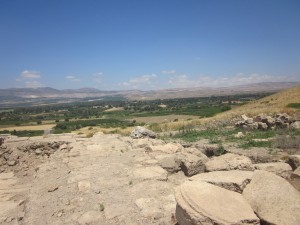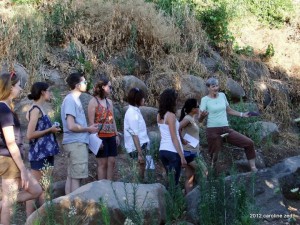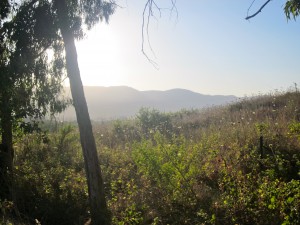My classmates have done an excellent job describing our initial reactions upon arriving in Israel and some of our experiences working at Omrit and visiting other sites. I would like to go into some detail on another topic that I knew nothing about before arriving here—the history of the kibbutz where we are staying. When we first arrived at the kibbutz I felt regrettably ignorant of many aspects of Israel’s modern history, but the location of Kefar Szold, our kibbutz, provoked reflection on this region’s recent past. Kefar Szold is situated near the Golan Heights, an area that Israel annexed from Syria in the 1967 war, and the border between Israel and Lebanon is visible from Omrit. I have found that one of the challenges of doing archaeology in Israel for me is balancing my understanding of the classical significance of Omrit with my goal of obtaining a better grasp on Israel’s more recent history.
Greta, our host during our stay at Kefar Szold, gave us a walking tour of the kibbutz and recounted her memories of its earlier days. Kefar Szold was founded in 1942. It was organized on a socialist model in which the community remained largely self-contained. The members of the kibbutz received regular stipends, with each person collecting the same amount of money regardless of the work he or she performed. The kibbutz provided many products for community use; Greta recalled how members would not even have to purchase their own vehicles because they could borrow the kibbutz cars for their transportation needs.
For a time in Kefar Szold’s history children were raised communally. They lived in children’s homes and visited their parents during the day. Greta pointed out some of the buildings that had been used as children’s homes while explaining that this practice was eventually terminated. It had not been popular with the adults who had grown up in this system, and as a result many of them chose not to raise their own families on the kibbutz. This led to somewhat of a population crisis for Kefar Szold, though in recent years the number of children being raised on the kibbutz has grown.
It is clear today that the kibbutz has shifted away from its socialist origins, as have many of the other kibbutz communities in the area. They have become interdependent—for example, Kefar Szold specializes in air conditioning and heating systems, so when a neighboring kibbutz needs work done on their air conditioners, Kefar Szold performs the maintenance. Another example of this development is the fact that our laundry is not washed at Kefar Szold but sent to a nearby kibbutz and then returned to Kefar Szold once it has been cleaned.
Kefar Szold’s shift from small-community socialism is also evident in the new stipend system. For those residents of the kibbutz who still are members, the size of the stipend now depends on the type of labor performed. This has allowed some community members to start remodeling projects for their homes. On our walk with Greta we saw signs and fences designating private property as well as personal cars parked in driveways. These indicators of personal property would not have been nearly so prominent in the kibbutz’s early days.
Today the kibbutz is very relaxing. It has beautiful views of the valley, lush vegetation, and an abundance of ice cream (though the rumor is that the kibbutz store stocks up on ice cream for our archaeological season). In a way this removes us from the intensity of the disputes over this region while also allowing us to understand some of the reasons this place has been so contested.



